| |
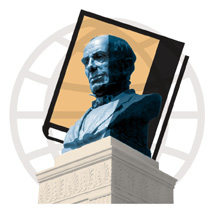
Wholly Hopkins
Matters of note from around Johns Hopkins
 University: In the wake of attacks, university
mourns
University: In the wake of attacks, university
mourns
 Astronomy: Observing the heavens from a desktop
Astronomy: Observing the heavens from a desktop
 University: Lead study fallout lingers
University: Lead study fallout lingers
 Homewood: Cancer trial in India draws fire
Homewood: Cancer trial in India draws fire
 Nursing: Addressing a hidden killer in South
Africa
Nursing: Addressing a hidden killer in South
Africa
 Art History: Of sprites earthy and sublime
Art History: Of sprites earthy and sublime
 Health: Physician, heal the system
Health: Physician, heal the system
 Biomedicine: New efforts to engineer tissue begin to
gel
Biomedicine: New efforts to engineer tissue begin to
gel
 Historic Houses: A palette for life's
lessons
Historic Houses: A palette for life's
lessons
 Alumni: Catching up with Greg Drozdek '95
Alumni: Catching up with Greg Drozdek '95
 In Memoriam: A voice that will be missed
In Memoriam: A voice that will be missed
University
In the Wake of Attacks,
University Mourns
As twilight faded into purple darkness on September 13, two
days after the fateful attack on America, hundreds of Johns
Hopkins students, faculty, and staff gathered as one
community on Homewood's Upper Quad. While some bowed their
heads in prayer, others embraced tearfully or stared
uncomprehendingly into the cool night air.
The diverse gathering--some 1,500 strong of Jews,
Muslims, Christians, and Hindus--shared an intimacy born of
collective grief. From her spot on the steps of Gilman Hall,
university chaplain Sharon Kugler,
with President William R. Brody,
led those assembled in seeking the courage to move forward:
"May we offer the power of our sorrow to the service of
something greater than ourselves," she said. "We must
understand that acts of terror are not religious acts. They
are shameless acts of evil and ignorance."
|
Scenes from the vigil held on the Homewood
campus
Photo by Jay Van
Rensselaer |
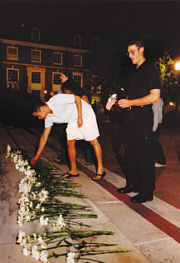 As the vigil drew to a close, many moved to the Gilman
Hall steps to lay white carnations, symbols of the miracle
and sanctity of life. And they lingered. Kugler would say
later, "I was amazed at the number of people who stayed
after. There was this yearning to keep connected with other
people who are also feeling this tragedy so intensely--a
certain kind of intimacy that we all shared."
As the vigil drew to a close, many moved to the Gilman
Hall steps to lay white carnations, symbols of the miracle
and sanctity of life. And they lingered. Kugler would say
later, "I was amazed at the number of people who stayed
after. There was this yearning to keep connected with other
people who are also feeling this tragedy so intensely--a
certain kind of intimacy that we all shared."
There would be other opportunities for members of the
Hopkins community to join together, including a student-led
prayer service the next day, initiated by leaders of the
Muslim student group; a march for peace over the weekend,
involving students from several area colleges and ending in
front of the Homewood campus; jam-packed religious services
for students of every faith at the Bunting-Meyerhoff
Interfaith Center; and, several weeks after the tragedy, a
Speak Out Against Hatred event at the Glass Pavilion,
sponsored by members of SEED (Students Educating and
Empowering for Diversity).
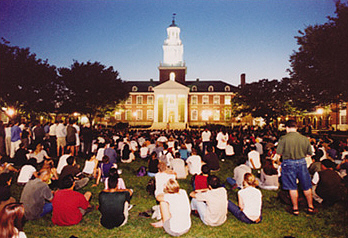
For those touched personally by the tragedy--there are
Hopkins students who lost parents, cousins, an uncle, and
close friends--the wounds are still raw, the grieving
process just begun.
But Kugler, and others, draw some measure of hope from
the way members of the Johns Hopkins community united at the
September 13 vigil to mourn and gain strength from one
another. "It isn't something we do easily here at Hopkins,
to take ourselves away from our duties, our jobs, our
intellectual pursuits," said Kugler. "But on that Thursday,
because we gathered, we gave ourselves permission to do it."
--Sue De Pasquale
University
Wolfowitz Ponders Legacy
of Terrorist Attacks
"The whole civilized world has been shocked by what has
happened, and some elements of the uncivilized world are
beginning to wonder if they are on the wrong side. We have
unfortunately entered a new era, and we are going to be
sorely tested," said U.S. Deputy Secretary of Defense Paul
D. Wolfowitz, former dean of Hopkins's
Nitze School of Advanced
International Studies, at a Pentagon press conference
after the September 11 terrorist attacks on New York and
Washington.
Astronomy
Observing the Heavens
from a Desktop
In the 19th century, astronomers put their eyes to
telescopes and sketched what they saw, one object at a time.
They were restricted to visible light--to draw it, they had
to see it. Then photography began recording images, and film
became the data collector; faster and more sensitive, film
expanded the astronomer's spectrum somewhat past the visible
range at the red and violet ends. Now instruments that can
detect a vast range of the spectrum--visible light,
infrared, ultraviolet, X-rays, gamma rays, radio waves--are
conducting comprehensive astronomical surveys and gathering
information digitally at extraordinary speed. The result is
a tsunami of data. "It's becoming increasingly easier to
collect data than to make sense of it," says Alex Szalay.
|
Szalay: harnessing a tsunami of data
Photo by Mike
Ciesielski |
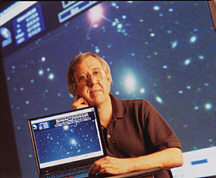 So Szalay, Hopkins professor of
astronomy and a
principal collaborator on the
Sloan Digital Sky Survey
(Hopkins Magazine,
April 2001), has become one of the prime movers behind
the National Virtual Observatory. The NVO, as envisioned by
Szalay and fellow astronomers and computer scientists at
nearly two dozen institutions, will be a digital network
linking astronomers, observatories, astronomical databases,
and educational institutions. The network will permit almost
any desktop computer to become a sophisticated virtual
observatory.
So Szalay, Hopkins professor of
astronomy and a
principal collaborator on the
Sloan Digital Sky Survey
(Hopkins Magazine,
April 2001), has become one of the prime movers behind
the National Virtual Observatory. The NVO, as envisioned by
Szalay and fellow astronomers and computer scientists at
nearly two dozen institutions, will be a digital network
linking astronomers, observatories, astronomical databases,
and educational institutions. The network will permit almost
any desktop computer to become a sophisticated virtual
observatory.
The National Science Foundation just awarded the
project a $10 million grant. Institutional players include
Hopkins, the California Institute of Technology, and the
Space Telescope Science Institute.
Says Szalay, "An astronomer used to get some telescope
time, collected data, brought the data tapes back to his own
computer, and made sense of it there." Now, he says, a
single night's observation may produce so much data the
astronomer cannot, in effect, carry it all away. The planned
Large Synoptic Survey Telescope will produce more than 10
petabytes of data per year by 2008--that's 10 million
gigabytes from a single instrument. (In comparison, a
typical desktop Mac or PC will have a hard drive of 20 to 30
gigabytes.)
Compounding the problem, says Szalay, is that this data
is not static. The sky changes day by day because everything
is in motion. Plus, astronomers must constantly apply
corrections to their data to account for things like
atmospheric effects and optical distortion. With each
refinement, the dataset changes.
Several challenges must be tackled before the NVO can
come to fruition. Scientists need to develop a common format
for their databases, so that data collected from, say, the
Hubble Space Telescope and the Chandra X-Ray Observatory are
accessible to any astronomer in the world and can be
manipulated by common tools. Someone has to write code to
retrofit existing databases to a new standard. Such huge
fields of data will require vastly more efficient databases
and faster, more precise search engines, to enable rapid
data searches, sorts, and retrievals. To handle the
statistical analyses, scientists will need better algorithms
to crunch massive amounts of data. Says Szalay, "We can't
throw a billion computers at it. We need more clever ways to
work with the data." Finally, the NVO will need rapid data
transmission capabilities ... a very wide pipe, in Internet
parlance.
Now that significant funding is in place, says Szalay,
"we need to do a lot of small things first, to make sure we
are on the right track." There will be, says Szalay, a lot
of meetings: "If you lock a lot of smart people in a small
room, good things come out of it." --Dale Keiger
University
Lead Study Fallout
Lingers
An August ruling made by the Maryland Court of Appeals
raised important questions about the future of public health
research involving children. At issue: Is it ethical to
enroll children in clinical trials that could pose risks?
The case involves a
Kennedy Krieger
Institute study of low-cost lead abatement efforts in
East Baltimore, where an estimated 95 percent of homes have
high lead levels. For the small children living in these
homes, lead exposure can be devastating, contributing to
brain damage, reduced intelligence and attention span,
hearing loss, and learning and behavior problems.
The three-year study, conducted from 1993 to 1995, was
led by Mark Farfel, a researcher at Hopkins's
Bloomberg School of Public
Health. The study looked at whether less expensive
abatement strategies could be effective in reducing lead
hazards. Researchers found that even minimum strategies--
such as limited repainting, professional cleaning to remove
lead dust, and stabilizing of exterior lead paint--
significantly reduced home lead levels and led to a lasting
reduction in children's elevated lead levels, to below the
"level of concern."
According to Kennedy Krieger officials, the study
ensured that the families in the study had vastly less lead
exposure than other families in the neighborhood. Children
also received regular blood tests and medical check-ups,
said Gary Goldstein, Kennedy Krieger president.
But two mothers brought suit against Kennedy Krieger,
charging researchers had allowed their children to live in
homes with incomplete removal of old lead paint, and that,
as a result, their children suffered brain damage.
In ruling that the suits could move forward, Maryland
Court of Appeals judge Dale Cathell compared the Hopkins
study to the infamous Tuskegee syphilis experiment and to
experiments inflicted upon prisoners at Buchenwald during
World War II. The strongly worded ruling prohibited any
future medical experiments on children that pose "any risk"
and that do not directly benefit the children.
"This decision could have enormously broad
implications, because almost all studies involve risk,"
responded Hopkins University President William R. Brody.
Bloomberg School of Public Health Dean Alfred Sommer
criticized the ruling for implying that human subjects in
nontherapeutic trials "have nothing to gain and everything
to lose." Noted Sommer, "If that were a meaningful
distinction, most public health research, which aims to
prevent disease in the first place, would never be done,"
including the Salk polio vaccine.
Worried that the court's ruling could shut down many
pediatrics studies and drive research dollars out of the
state, Hopkins, Kennedy Krieger, University of Maryland
Medical System, and the Association of American Universities
in September asked the appeals court to modify its ruling,
changing "any risk" to "minimal risk," the language used in
federal regulations of human studies. In October, the court
modified the language as requested, making it possible for
many pediatrics studies to move forward.
But the court refused to back off from its reference to the
infamous Tuskegee studies. --SD
Homewood
Cancer Trial in India
Draws Fire
A clinical trial of an anti-cancer drug in India has drawn
the scrutiny of Johns Hopkins University officials after
physicians in India raised questions about the manner in
which the study was conducted.
The researcher was identified in a July 31, 2001,
Baltimore Sun article as Ru Chih C. Huang; Huang has
served on the biology
faculty of Hopkins's Krieger School of Arts and Sciences
since 1965. (Because of confidentiality policies, university
administrators did not release Huang's name and will neither
confirm nor deny her involvement.)
Conducted in 1999 and 2000, the clinical trial involved
26 cancer patients in Kerala, India. The study aimed to
determine whether a chemical derived from the creosote plant
could stop the growth of oral cancer.
In March, Hopkins officials learned that the principal
investigator of the study had not obtained approval from a
Hopkins institutional review board (IRB). The researcher
assured administrators that the study protocol had been
approved by appropriate authorities in India and that proper
informed consent was obtained.
According to the Baltimore Sun article, Huang
said she did not realize the university requires internal
approval of experiments abroad. "I will never do it again in
this way. But certainly I did not hurt the people in that
country in any way, and I think that this will prove to be
an effective anti-cancer drug," Huang is reported as
saying.
In March, the university counseled that the Hopkins
internal review should have been obtained and that a
proposed follow-up study would have to go before a Hopkins
IRB.
In mid-July, the Indian press reported allegations made
by physicians at the Regional Cancer Center in Kerala that
raised serious questions regarding how the cancer study was
conducted. The reported allegations included concerns about
whether proper informed consent had been secured, whether
the drug had been properly screened for toxicity, and
whether surgery or other conventional treatment had been
unnecessarily delayed.
After the accounts surfaced in the press, Hopkins
officials launched a preliminary inquiry which later
confirmed that the cancer study had not been reviewed or
approved by any of the university's IRBs.
The university convened an investigative panel "to
conduct a formal investigation to more fully develop the
facts." At press time, the investigation was not yet
concluded.
During the course of the investigation, the faculty
member in question has been directed by university officials
to stop all follow-up work related to the study.
--SD
Homewood
North Addresses Nuclear
Threat During MSE Symposium
"It's time to get a grip, to wake up to the fact that we've
been manipulated by the media. These stories about people
bringing in nukes in suitcases are about as likely to happen
as a meteor striking [Shriver Hall]. In order to put a nuke
in a suitcase, you'd need a W-88 warhead, the same warhead
the Chinese stole from Los Alamos. The Chinese have a ton of
money and intelligence and they still can't figure out how
to use it. Do you really think bin Laden's gonna figure it
out in a tent in Afghanistan?" scoffed Lt. Col. Oliver North
on September 27 in the second talk of this year's
student-run Milton S. Eisenhower
Symposium. The symposium's original theme, "A Nation
Divided: Politics and Power in the 21st Century," was
changed to "A Nation United..." after the September 11
attacks. Those slated to speak included Washington
Post writer Bob Woodward, civil rights activist Lani
Guinier, and U.S. Senator Russ Feingold.
Nursing
Addressing a Hidden
Killer in South Africa
 It is winter in Cape Town, South Africa, and a slight chill
invades the August air. In the black township of Crossroads,
just outside the city limits, the weak morning sunlight has
yet to burn off a low-hanging haze. Men, women, and children
wearing jackets and heavy sweaters gather in front of the
local government-funded clinic waiting for it to open. If
they are lucky, they will see a physician or nurse before
the day ends. If not, they will go home and return
tomorrow.
It is winter in Cape Town, South Africa, and a slight chill
invades the August air. In the black township of Crossroads,
just outside the city limits, the weak morning sunlight has
yet to burn off a low-hanging haze. Men, women, and children
wearing jackets and heavy sweaters gather in front of the
local government-funded clinic waiting for it to open. If
they are lucky, they will see a physician or nurse before
the day ends. If not, they will go home and return
tomorrow.
The clinic sits in the heart of the township, amid
homes that range from one-room makeshift shacks with no
electricity or running water to modest dwellings made of
cinderblocks.
|
Cape Town residents wait to be seen at the
clinic.
Photo by Allen
Jefthas |
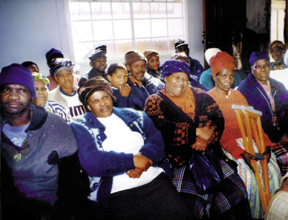 This particular morning follows a day of rioting that
took place near Crossroads. Gunfire erupted when hundreds of
black South Africans protested the poor living conditions in
an informal housing settlement. Police exchanged gunfire
with protesters, and the incident snarled traffic for hours.
Now, close to 24 hours later, most of the violence from the
protest has subsided, but rubble still litters some streets
and a few impromptu fires are still smoking.
This particular morning follows a day of rioting that
took place near Crossroads. Gunfire erupted when hundreds of
black South Africans protested the poor living conditions in
an informal housing settlement. Police exchanged gunfire
with protesters, and the incident snarled traffic for hours.
Now, close to 24 hours later, most of the violence from the
protest has subsided, but rubble still litters some streets
and a few impromptu fires are still smoking.
On their way by car to the Crossroads township are
nurse researcher Martha Hill, interim dean of Hopkins's
School of Nursing,
and physician Krisela Steyn, director of the Chronic
Diseases Lifestyle Program at the South African Medical
Research Council (MRC).
The two have joined forces to chip away at one of black
South Africa's greatest health risks: cardiovascular
disease. Hill has spent the past two weeks in Cape Town,
where she is overseeing completion of the first leg of a
study to control hypertension in black South Africans.
|
Nursing student Stacie Stender takes a patient's
blood pressure.
Photo by Allen
Jefthas |
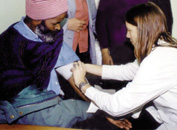 Next to AIDS, hypertension and cardiovascular disease
are the biggest killers of South Africans. According to MRC
researchers, about 10 percent of South Africans die each
year from heart disease; that figure might be as high as 25
percent because of inaccurate reporting of deaths in black
townships. More than 25 percent of South Africans have high
blood pressure, and a lack of knowledge about the condition
is particularly prevalent in the townships, where awareness
about hypertension gets lost in the shadow of AIDS, which
has hit South Africa harder than any other country in the
world. One in nine South Africans now tests positive for
HIV/AIDS.
Next to AIDS, hypertension and cardiovascular disease
are the biggest killers of South Africans. According to MRC
researchers, about 10 percent of South Africans die each
year from heart disease; that figure might be as high as 25
percent because of inaccurate reporting of deaths in black
townships. More than 25 percent of South Africans have high
blood pressure, and a lack of knowledge about the condition
is particularly prevalent in the townships, where awareness
about hypertension gets lost in the shadow of AIDS, which
has hit South Africa harder than any other country in the
world. One in nine South Africans now tests positive for
HIV/AIDS.
Raising awareness about hypertension in hard-to-reach
populations is nothing new for the energetic Hill. For more
than 10 years she has researched ways of controlling
hypertension in young, urban, African-American males. With
colleagues from other divisions within Hopkins, Hill devised
a model of personalized care using a team of nurse
practitioners, physicians, and community health workers. The
model, which aggressively tracks men with high blood
pressure, succeeded in controlling the hypertension rates of
almost 40 percent of a group of 309 African-American men in
East Baltimore. With a grant from the Fogarty International
Center of the National Institutes of Health, Hill is working
with MRC researchers to replicate the Baltimore hypertension
study in three South African townships. As part of the
School of Nursing's Global Health Promotion Research
Program, Hill had three students assisting with the study.
They spent the summer working in the Crossroads clinic,
developing questionnaires that determine the barriers
preventing black South Africans from controlling their
hypertension.
"It's a real challenge," says Hill as she walks through
the crowded Crossroads clinic. "If you ask people what is
high blood pressure, they have many different ideas and
don't always understand the lifestyle relationship."
|
Martha Hill and South African nurse researcher Thandi
Puaone check out one of the city's popular grills, featuring
fat-laden and salty meats.
Photo by Kate
Pipkin |
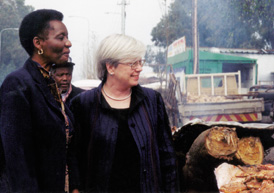 In a small room at the clinic, Hill watches closely as
Hopkins nursing graduate student Stacie Stender measures the
blood pressure of William Qomoyi. It is 175/90--well above
the "normal" range of 140/80. Stender tests it again to be
certain. Qomoyi claims that because he drinks a traditional
beer brewed in the township, he does not have high blood
pressure--a belief held by more than one patient. Stender
makes arrangements for him to get a prescription for blood
pressure medication, then hands him a loaf of bread as
thanks for participating in the study and calls in the next
patient. This man's blood pressure tops out at 225/110.
In a small room at the clinic, Hill watches closely as
Hopkins nursing graduate student Stacie Stender measures the
blood pressure of William Qomoyi. It is 175/90--well above
the "normal" range of 140/80. Stender tests it again to be
certain. Qomoyi claims that because he drinks a traditional
beer brewed in the township, he does not have high blood
pressure--a belief held by more than one patient. Stender
makes arrangements for him to get a prescription for blood
pressure medication, then hands him a loaf of bread as
thanks for participating in the study and calls in the next
patient. This man's blood pressure tops out at 225/110.
Hill and her students encountered other cultural
beliefs besides the traditional beer "cure." Many residents
of black townships are reluctant to have their height
measured, since they think it means they are sick and being
measured for a coffin. A particularly deadly belief among
black South African women is the idea that obesity is a
desired state; being large is associated with being
dignified, well-off, AIDS-free, and healthy.
Hill is quick to point out that cultural practices are
not the only barrier to controlling hypertension. Lifestyle
changes are also to blame. After apartheid was abolished in
1994, many rural black South Africans moved to urban areas
such as Cape Town in search of work and a better life. So
far, city living has only given them a more sedentary
lifestyle complete with poor diet. Vendors set up crude,
homemade grills on street corners in the townships where
they fry up fatty, salty cuts of meat to sell at a low cost.
It is a popular meal among black South Africans with limited
income.
The better quality of life sought by so many is proving
elusive. According to nurse Zodwa Maxhama, who works in the
Crossroads clinic, many older blacks watched their children
die of AIDS and now have become the primary caregivers for
their HIV-positive grandchildren. "They have a great deal of
stress," says Maxhama. "They have no job, no food, and
family problems." Against this backdrop, controlling
hypertension often falls to the bottom of the priority
list.
Notes Hill, "Often the people who have hypertension are
the ones who are working and carrying the already-fragile
economy. If the head of a household has a stroke, the toll
in death and disability ends up having a socioeconomic
impact. Prevention is the key."
Hill hopes the model she is trying to implement will
make a difference, despite the overwhelming hypertension
rates: "As nurses, we tend to be passionate about care, but
unless you have good data to back it up, you will have
little effect on changing practice." --Kate Pipkin
Art History
Of Sprites Earthy and
Sublime
In 15th-century Italy, the sculptor Donatello reached back
to antiquity for a decorative figure: a nude, winged young
boy found on ancient Roman sarcophagi. The figure has lasted
to this day as Cupid, the diminutive archer of love. But in
the art of Renaissance Italy, says Charles Dempsey, Hopkins
professor of art history, these
figures, called putti, represented a much wider assortment
of spirits. They were central to the melding of the
classical and the vernacular that is at the heart of
Dempsey's view of Renaissance art.
|
|
From the George Peabody Library collection,
Spiritelli Harvesting the Grape, a woodcut from
Francesco Colonna's book Hypnerotomachia Polifili
(Venice, 1499). |
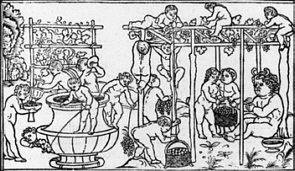 "The art of the Renaissance period has normally been
characterized as having to do with the revival of
antiquity," says Dempsey. "My argument is that in Italy
there are two deep cultural traditions. One is indeed the
ancient tradition. But the other is the vernacular
tradition, which is the tradition of poetry and art created
in native Italian, so to speak, from the time of Dante,
Petrarch, and Boccaccio." The putto, Dempsey says, is an
example of such vernacular expression. "It does derive, to
be sure, from ancient Roman sarcophagi, but at the same time
it's defined by this term spiritello"--spirit, or sprite--
"which is a term that only has meaning in the native
Italian. It doesn't have any Latin equivalent."
"The art of the Renaissance period has normally been
characterized as having to do with the revival of
antiquity," says Dempsey. "My argument is that in Italy
there are two deep cultural traditions. One is indeed the
ancient tradition. But the other is the vernacular
tradition, which is the tradition of poetry and art created
in native Italian, so to speak, from the time of Dante,
Petrarch, and Boccaccio." The putto, Dempsey says, is an
example of such vernacular expression. "It does derive, to
be sure, from ancient Roman sarcophagi, but at the same time
it's defined by this term spiritello"--spirit, or sprite--
"which is a term that only has meaning in the native
Italian. It doesn't have any Latin equivalent."
Dempsey makes his case in a new book, Inventing the
Renaissance Putto (University of North Carolina Press,
2001). To the Renaissance audience for art, the putti were
not just little gods of love, but spiritelli, the
spirits that animate bodily functions, muddle the head after
the consumption of wine, and cause involuntary reactions
such as fright or sexual arousal.
Dempsey contends that many forms of 15th-century
painting, including the putto, responded to everyday
experience. "And everyday experience is something that's
lived in terms of the vernacular, not in terms of some
remote, classical past. The putto has a classical pedigree,
but a vernacular name and meaning. The spiritelli are very
deeply embedded in medieval and Renaissance physiological
concepts. They refer to how the body works, how it processes
sensations from outside. People in the 15th century had no
concept of the circulation of blood, so that [the] pulse,
which they could feel, was something generated by active
spirits in the body."
A central element of Dempsey's book is a new reading of
Botticelli's Mars and Venus. In the painting, a
lovely, serene Venus reclines beside an all-but-naked Mars,
who slumbers in what has most often been read as amorous,
even postcoital, bliss. Completing the composition are four
putti playing with Mars's lance and armor. Dempsey looks at
this classical subject and sees not bliss, but "a nightmare
of sexual obsession and domination, of a soul possessed and
tormented, not just by erotic fantasies, but by the demons
of Mars's own moral confusion." The putti, in this new
reading of the painting, are not classical allusions to
love, but vernacular representations of spirits of fright,
the torment of nightmares.
Dempsey notes how, after Donatello first employed the
device, it soon appeared throughout Renaissance art. "It
spread faster than e-mail. It was amazing how quickly this
was picked up. It was a successful and appealing invention,
a device that worked because everybody understood it.
"And they're cute." --DK
Health
Physician, Heal the
System
Future physicians know they will face hurdles in their
efforts to heal the sick: the high cost of prescription
drugs, the lack of adequate health care coverage, and
treatment barriers created by such issues as substance
abuse, domestic violence, and poverty.
A new student-generated course at the Hopkins
School of Medicine is meant to help first-year medical
students learn ways to go beyond their role as caregivers--
to work as political activists in addressing the underlying
weaknesses in providing medical care.
|
|
Illustration by Wesley
Bedrosian |
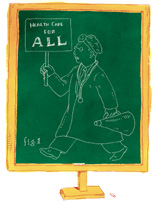 "We hope to get them exposed to all different ways that
a physician can be involved, not just in medicine, but more
broadly speaking in health care, and to do that in a way
that makes a difference," says Todd Varness, a fourth-year
Hopkins medical student who helped create the course. "We
want to catch them early when they have a lot of idealism. I
saw a lot of my classmates come in with idealism, but
unfortunately that can get beaten out of you over four
years."
"We hope to get them exposed to all different ways that
a physician can be involved, not just in medicine, but more
broadly speaking in health care, and to do that in a way
that makes a difference," says Todd Varness, a fourth-year
Hopkins medical student who helped create the course. "We
want to catch them early when they have a lot of idealism. I
saw a lot of my classmates come in with idealism, but
unfortunately that can get beaten out of you over four
years."
The Research-Based Health Activism class is being
taught for the first time this fall. Through guest speakers,
seminars, and case studies, a dozen medical students are
learning to do database searches, conduct surveys, and work
with the media. The goal: to develop a research question and
protocol to pursue during their years at Hopkins.
One project, for example, could include surveying
children for their responses to alcohol advertising, and
writing a policy paper. Another might entail finding out why
patients aren't making their doctor's appointments, and
lobbying City Hall for better public transportation.
Varness, who has a master's in public health and plans
to finish his medical degree in May, is helping manage the
course with Paul Jung, a Hopkins Robert Wood Johnson
Clinical Scholar, and Richard Humphrey, Hopkins associate
professor of medicine. The class is based on courses
developed by Peter Lurie, a former faculty member at the
University of Michigan and deputy director of Public
Citizen's Health Research Group. Lurie will be one of the
guest speakers.
Says Jung, "If anyone wants to get anything done in
health care they have to understand politics. You can be the
best diagnostician in the world, you could make a diagnosis
from 20 feet away, but it will not help your patients if
they can't get cheaper medicine." --JCS
Biomedicine
New Efforts to Engineer
Tissue Begin to Gel
One of the most intriguing bits of engineering in Clark
Hall, the newest building on the Homewood campus, is a
scaffold.
Not the wooden framework for the Georgian-style brick
building, but the concept of a tiny scaffold of
biodegradable polymers or other materials upon which
researchers hope to build knee cartilage, liver tissue, a
heart valve, or, someday, an entire beating human heart.
The three-story Clark Hall, which this fall started
housing faculty from Hopkins's recently launched Whitaker
Biomedical Engineering Institute, includes lab space for
researchers tackling a relatively new field of science:
tissue engineering. In particular, Hopkins scientists are
looking at the interaction between the body's cells and the
scaffold surfaces required for complex tissue to grow.
Jennifer Elisseeff and Kevin Yarema, both assistant
professors of biomedical
engineering in the Whiting School of Engineering, are
suitemates--106A and 106B. Elisseeff is working on new
biomaterials for scaffolds. Yarema considers himself a cell
engineer. As Yarema notes: "You have to make the scaffolding
more friendly to the cell or the cell more friendly to the
scaffolding."
|
Jennifer Elisseeff and Kevin Yarema in the lobby of the
new Clark Hall, below right.
Photo by Chris
Hartlove |
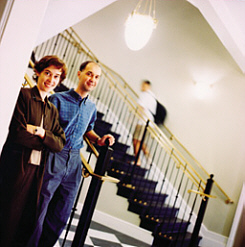 Tissue cells grown in a petri dish are usually little
more than a thin film. So building effective scaffolds--
often biodegradable materials that would melt away as cells
grow and divide--would allow the engineering of more complex
organs or body parts. The scaffold could be molded in the
shape of an ear, for example. In other advances, skin and
cartilage are already being grown on scaffolds in the lab,
and coral has been used as the internal structure on which
to rebuild a man's thumb.
Tissue cells grown in a petri dish are usually little
more than a thin film. So building effective scaffolds--
often biodegradable materials that would melt away as cells
grow and divide--would allow the engineering of more complex
organs or body parts. The scaffold could be molded in the
shape of an ear, for example. In other advances, skin and
cartilage are already being grown on scaffolds in the lab,
and coral has been used as the internal structure on which
to rebuild a man's thumb.
But questions among researchers at Hopkins and
elsewhere remain numerous: Which is the best surface on
which to grow skin or heart cells? How would the cells stick
to the surface and begin to divide? How would the body take
over, with a little help from chemical growth factors, and
create new tissue nurtured with blood vessels?
Elisseeff, building on her earlier PhD research at MIT,
is working on malleable scaffolds made up of cell-laced
polymer hydrogels. The viscous gels, which have been
described as a sort of "living glue," contain encapsulated
cells that act as seed cells for new tissue growth. The
hydrogel is hardened into a supportive scaffold through
exposure to light, a process known as
photopolymerization.
|
|
Hopkins biomedical engineers are looking at interaction
between the body's cells and the scaffold surfaces required
for complex tissue to grow. |
Doctors have already used polymer gels and
photopolymerization to create coatings for artificial
implants, to restore bone, and even for dental fillings. But
one hurdle looms: The polymer gels must be exposed to light
in an "open area," which means doctors are trying to implant
the self-hardening material during surgery. The result: Gels
exposed to certain temperatures harden too soon or in the
wrong shape.
Elisseeff, after speaking with doctors encountering
problems, theorized that photopolymerization could also work
through layers of skin. That method would allow a surgeon to
use arthroscopic surgery, injecting an unhardened hydrogel
directly into the location, such as a knee, to help build
new cartilage tissue. The less invasive method showed
success in studies with lab mice at MIT. "We want to be able
to give physicians more control to shine the light when they
want and where they want," she says. Among other research
goals at Hopkins, Elisseeff is testing ways to extract
components from human cartilage tissue to create new
biological-based hydrogels to build scaffolds even more
compatible with living tissue.
Yarema, meanwhile, is focused on changing the tissue
cells, "to make the cell work more compatibly with the
scaffold," he says. One of his thrusts, based on his
postdoctoral research at the University of California,
Berkeley, is exploring the molecular surface of the cell. He
has focused specifically on sialic acid, a sugar on the
surface of cells that's important in biological processes,
including brain development.
Yarema and his fellow researchers at Berkeley added a
variation of a different sugar, ManNAc, to cells in hopes of
altering the molecular structure of sialic acid on the
cells' surface, making the cells easier to target. When
processed through the cells' biological pathways, the
altered sugar did change sialic acid, introducing ketones,
or chemical groups not usually found on the cell's surface.
Yarema believes these new ketones could "provide a unique
chemical handle on the cell's surface" poised to accept a
targeted chemical link on the scaffold. At Hopkins, Yarema
will test other modified sugars and look for ways to make
the connection work in a way that could be used to build
tissue.
The cell-to-scaffolding interaction is especially
important when engineering new tissue from stem cells, the
undifferentiated cells found in fetal tissue or adult human
bone marrow. "We need to engineer surfaces that are optimum
for stem cells to grow," says Murray Sachs, Hopkins director
of the Whitaker BME Institute. "How do you create an
environment where cells can differentiate into nerve cells
or heart muscle cells or bone cells?"
The answers will likely come from various quarters.
Sachs, Elisseeff, and others point out that tissue
engineering is an edgy, interdisciplinary science. The
field, which came into existence only a decade ago, brings
together biologists, orthopedic surgeons, computer
scientists, plastic surgeons, neurologists, cardiologists,
stem cell researchers, and engineers who specialize in
fields ranging from materials science to chemical
engineering.
 About a dozen Hopkins faculty are tackling research
questions along these lines, including Leslie Tung,
associate professor of biomedical engineering, whose work
focuses in part on developing engineered heart muscles that
contract, and Kam Leong, professor of biomedical
engineering, who is synthesizing new biodegradable polymers
that could be useful in scaffolds. Christopher Chen,
assistant professor of biomedical engineering, is delving
into cells and their micro-environment, analyzing how
cell-to-cell signaling and microfabricated surfaces
influence cell proliferation and death.
About a dozen Hopkins faculty are tackling research
questions along these lines, including Leslie Tung,
associate professor of biomedical engineering, whose work
focuses in part on developing engineered heart muscles that
contract, and Kam Leong, professor of biomedical
engineering, who is synthesizing new biodegradable polymers
that could be useful in scaffolds. Christopher Chen,
assistant professor of biomedical engineering, is delving
into cells and their micro-environment, analyzing how
cell-to-cell signaling and microfabricated surfaces
influence cell proliferation and death.
Potential applications for such tissue engineering
research hold out great promise: Perfect new skin grown for
burn victims, new inner ear cells generated to restore
hearing to the deaf, or nerve cells grown to reverse
paralysis. And patients needing organ transplantations
wouldn't be plagued by the scarce availability of donor
organs, or the problems of infection or durability linked to
artificial hearts and other organs made of metal, ceramics,
or Dacron. --JCS
Historic
Houses
A Palette for Life's
Lessons
During the early 1800s, needlework was a primary means of
educating girls in America: a hands-on way for them to learn
geography, history, French, English, arithmetic, and other
subjects. In Maryland and elsewhere, needlework also
provided a parlor room palette on which to teach lessons
about morality and domestic life.
At Hopkins's
Homewood House Museum, examples of such work are being
exhibited and discussed in a fall exhibit titled "Needles
and Threads: Women's Handiwork, Men's Craftsmanship." The
exhibit, which runs through November 25, also features
mahogany work tables and other furniture crafted by Maryland
cabinetmaker John Needles and his young male apprentices, as
well as English embroidery scissors, pincushions, sewing
boxes, and girls' needlework samplers.
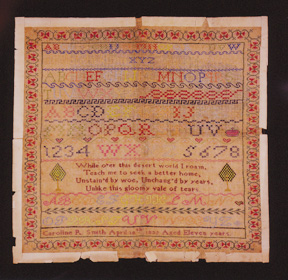 One vividly preserved 1832 example by 11-year-old
Caroline R. Smith of Maryland likely has never been
displayed before, curators believe. (Many samplers are faded
because vegetable dyes then used to color embroidery threads
are highly sensitive to light.) Smith's neatly wrought,
deeply colored sampler (shown at right) includes classically
inspired motifs such as waves and laurel leaves, as well as
a verse typical of the time period.
One vividly preserved 1832 example by 11-year-old
Caroline R. Smith of Maryland likely has never been
displayed before, curators believe. (Many samplers are faded
because vegetable dyes then used to color embroidery threads
are highly sensitive to light.) Smith's neatly wrought,
deeply colored sampler (shown at right) includes classically
inspired motifs such as waves and laurel leaves, as well as
a verse typical of the time period.
"Mourning embroideries became very popular," says
Catherine Rogers Arthur, curator of Homewood House. "It is a
sad reminder of how ever-present loss was in early
19th-century life. It was not uncommon for a girl of 11
years old to have lost siblings or a mother in childbirth.
It was very present in their minds. And they put a lot of
hope in the afterlife." --JCS
Alumni
Catching Up with Greg
Drozdek '95
Greg Drozdek '95 is once again uniting two worlds he knows
well: the New York streets and reaching out to children.
Drozdek was featured in our February 1995 issue in
"A Long Way from the
Old Neighborhood," which described his experiences as a
homeless 16-year-old in New York City. He managed to put
himself through Catholic high school and eventually talked
his way into Hopkins, where he played football and founded
the Hopkins Student-Athlete Mentoring Program.
Today, Drozdek is continuing to help at-risk kids
through the Stanton Street Settlement, a privately
supported, non-profit learning center he founded in 1999 for
children in New York's Lower East Side. He also teaches
English at Manhattan's La Salle Academy and is completing a
PhD in educational administration at New York University.
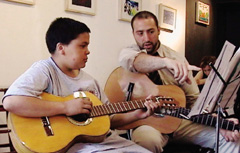 Drozdek patterned Stanton Street Settlement after the
first American settlement house, Jane Addams's Hull House,
which opened in Chicago in 1889. The idea, borrowed from
England, was to provide education and social services to the
urban poor. Drozdek had noticed an empty storefront, and in
what he describes as
Drozdek patterned Stanton Street Settlement after the
first American settlement house, Jane Addams's Hull House,
which opened in Chicago in 1889. The idea, borrowed from
England, was to provide education and social services to the
urban poor. Drozdek had noticed an empty storefront, and in
what he describes as
a "bells of St. Mary's moment," he conceived of a modern
settlement house to serve neighborhood immigrant kids.
He enlisted help from other Hopkins alumni--many now
serve on the settlement's board and as volunteers--and other
donors. The settlement
(
www.stantonstreet.org).
serves about 35 children, ages 4 to 13, providing
after-school tutoring, a chess program, field trips, and
cooking, computer, and fitness classes. Says Drozdek, "We're
offering the extra programs that public schools have been
forced to cut." --DK
In Memoriam
A Voice That Will Be
Missed
Peter W. Jusczyk, a Hopkins
psychology professor
who was an internationally regarded pioneer in the study of
infant language perception and speech development, died
August 23 while attending a scientific meeting in
California. He was 53.
Jusczyk's unexpected death stunned students and faculty
in the Krieger School of Arts and Sciences, where he was
known for the Infant Language Research Laboratory that he
operated with his wife and fellow Hopkins researcher, Ann
Marie Jusczyk. Through studies involving hundreds of babies,
he and his colleagues showed infants are able to recognize
and process sounds related to language at very young ages.
(See "The Origins of
Babble," Hopkins Magazine, February 1998.) In
1997 he published an influential book on the subject, The
Discovery of Spoken Language.
|
Peter Jusczyk with some young friends
Photo by Jay Van
Rensselaer |
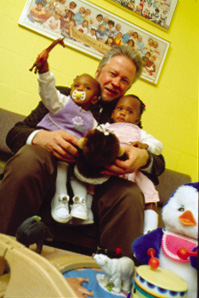 "Peter was passionate about everything he did, either
in a professional context or for fun," says Greg Ball,
psychology professor at the Krieger School and a friend of
Jusczyk's. "I was always impressed by the breadth of his
intellect. His thinking was influenced by ideas and findings
from many fields, ranging from linguistics to neuroscience
or even engineering." Among the many professional honors
Jusczyk received was his election last year to the
prestigious Society of Experimental Psychologists.
"Peter was passionate about everything he did, either
in a professional context or for fun," says Greg Ball,
psychology professor at the Krieger School and a friend of
Jusczyk's. "I was always impressed by the breadth of his
intellect. His thinking was influenced by ideas and findings
from many fields, ranging from linguistics to neuroscience
or even engineering." Among the many professional honors
Jusczyk received was his election last year to the
prestigious Society of Experimental Psychologists.
In 1999, Jusczyk and colleague Ruth Tincoff presented
the first-ever evidence that infants as young as 6 months
can associate words with meanings. The words with meanings
were the crucial childhood words of "mama" and "dada."
"Most of the previous work on comprehension indicated
it was 8 or 10 months of age when kids started to attach
labels to particular objects," Jusczyk said at the time.
"The difference here is the words name important social
figures. This suggests that infants begin forming a lexicon
with sound patterns linked directly to socially significant
people, such as their parents."
Another aspect of Jusczyk's research focused on
determining when infants were able to distinguish between
sounds of their native language and other languages based on
common sound patterns in their native tongue. He showed that
this ability developed sometime between the sixth and the
ninth month of infancy. --Michael Purdy
 Return to November 2001 Table
of Contents
Return to November 2001 Table
of Contents
|















 The Johns Hopkins Magazine | The Johns Hopkins University |
3003 North Charles Street |
The Johns Hopkins Magazine | The Johns Hopkins University |
3003 North Charles Street |